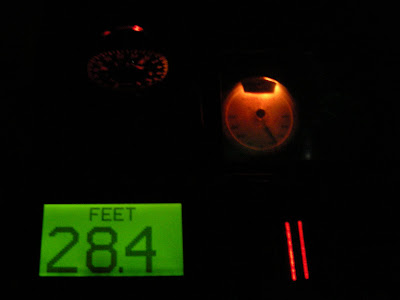
I'm in danger here of stepping into deep water and trying to explain a subject of which I have a very scanty understanding. Peter asked what the numbers on a lifeboats hull mean? Well, they are the operational number for the lifeboat and are the lifeboats true identity. However, each lifeboat can also be referred to in at least 3 other ways:
For example, our ALB is number 12-23. The 12 denotes that it is a Mersey class, and the 23 is it's sequential build number. Hence 12-23 is the 23rd Mersey class lifeboat. This number is used when we are on passage and talking to the Coastguard, as in 'Portland Coastguard, this is Lifeboat 12-23'.
While on service it is referred to as 'Swanage Lifeboat'. Any lifeboat that we are operating on service from Swanage is known as Swanage lifeboat. So if we have a relief lifeboat it temporarily becomes Swanage Lifeboat.
Each boat has a further number, it's 'ON' number. Ours is ON-1182. This is the number that the boat is assigned in build before it has been allocated to a station or given a class number. In a sense this is the true 'legal' identity of the boat and is how it is referred to by the engineers and mechanics.
Of course it then has a name, RNLB Robert Charles Brown. To be honest, it is seldom if ever referred to using this name.
And where do you find these names and numbers? 12-23 is painted on each bow. Swanage Lifeboat is painted on the transom. Robert Charles Brown is painted on each side of the wheelhouse. ON1182 is cast on a metal plaque contained in the wheelhouse.
And other lifeboats?
Well, the Arun class were numbered 52, most then had a 2 digit number following this as in 52-02, though some had a 3 digit number such as RNLB Snolda which was 52-030. This extra digit denoted that her hull was made of steel rather than wood or GRP. Tynes were numbered 47 followed by a 3 digit number also denoting a steel hull. Trents are numbered 14, Tamars 16, Seven class lifeboats numbers all begin with 17. There is then the odd other anomaly such as 12-001 which is a relief Mersey and has an extra digit due to being made of metal rather than GRP.
ILBs have a slightly simpler system in a sense. All 'D' class boats have a 3 digit number preceded by a D. Ours is D-613. They also have a name, again ours is the 'Jack Cleare'. It is referred to on the radio while on service as 'Swanage ILB'. When off service they are referred to by their numbers so our boat becomes 'Lifeboat Delta Six One Three'. Incidentally numbers above 600 are all of the IB1 type.
Atlantic class lifeboats have 3 digit number preceded by the letter B. Atlantic 21s started with numbers from 001 I believe. When the Atlantic 75 was introduced they were numbered sequentially from 700 and the 85s are numbered from 800 onwards.
The Tiger class lifeboats on the Thames have 3 digit numbers preceded by an E and hovercraft have a 3 digit number preceded by an H. That's right, they have a 3 digit number because the initial zero denotes a metal, in both cases aluminium, hull (thanks anon).
Daughter boats carried on ALBs are known as 'X' and 'Y' boats. We have an X boat...I can't remember it's number! 'X' boats with engines are known as 'XP' boats. On service our 'X' boat is referred to as 'Lifeboat X-ray'.
Phew!! Please let me know of any inaccuracies or anything which requires further explanation.
Ah well, I knew I wouldn't get it all perfectly right. A few more details for you (thanks Steve): The Numbers of each class refers to the length of the class. Merseys are 12m long, Tamars are 16m, Severns 17m and Tynes were 47ft. This also clears up something else which had confused me. I did say Arun class lifeboats were numbered 52 followed by numbers. The nagging doubt was that I was sure that Humber's old Arun, the 'City of Bradford IV', was numbered 54-03. And now I know why, 4 Aruns were built in GRP at 54ft rather than 52ft...how about that for a spotters detail!
Whilst on the subject of numbers it is worth noting that the RNLI has a typical seafarers attitude towards superstitions. Thus we have crew numbers but don't have a number 13. Anon has commented that there is no D-666, is there a 13th boat in each class? I wonder.
Thanks for all the comments, keep them coming please, I'm enjoying this!
 Never wishing to be far from the sea, my family and I have spent our holiday time this Christmas travelling to various aquatically far-flung corners of the country.
Never wishing to be far from the sea, my family and I have spent our holiday time this Christmas travelling to various aquatically far-flung corners of the country. 




























